In response to the increasing weight of airline passengers t
In response to the increasing weight of airline passengers, the Federal Aviation Administration in 2003 told airlines to assume that passengers average 190.1 pounds in the summer, including clothing and carry-on baggage. But passengers vary, and the FAA did not specify a standard deviation. A reasonable standard deviation is 36.5 pounds. Weights are not Normally distributed, especially when the population includes both men and women, but they are not very non-Normal. A commuter plane carries 22 passengers.
What is the approximate probability (±0.0001) that the total weight of the passengers exceeds 4572 pounds?
Solution
This is like asking the probability of the mean exceeding 4572/22 = 207.8181818.
We first get the z score for the critical value. As z = (x - u) sqrt(n) / s, then as
x = critical value = 207.8181818
u = mean = 190.1
n = sample size = 22
s = standard deviation = 36.5
Thus,
z = (x - u) * sqrt(n) / s = 2.276866828
Thus, using a table/technology, the right tailed area of this is
P(z > 2.276866828 ) = 0.01139709 [ANSWER]

 Homework Sourse
Homework Sourse